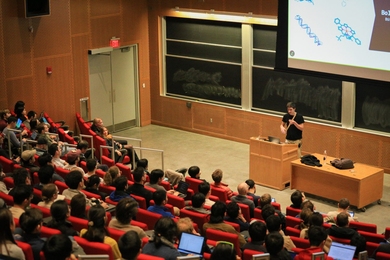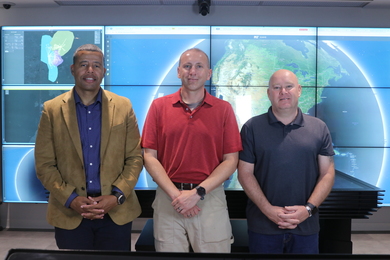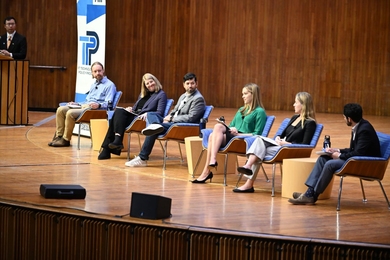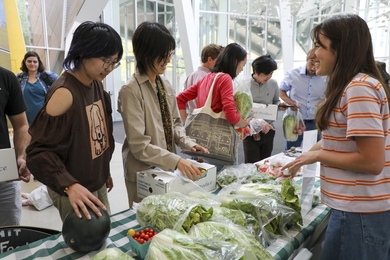(This interview was conducted by Space News in Springfield, VA, and published in its August 18 issue).
Ensuring safe, long-term human space travel tops the agenda of the National Space Biomedical Research Institute established in May by NASA and the Baylor College of Medicine in Houston. At the helm of this Houston-based institute is Laurence Young, Apollo Professor of Astronautics at MIT. The consortium that makes up the institute, which includes Baylor, conducts research considered key to keeping humans healthy during long-duration space flights.
As a member of MIT's research staff from 1958-62, Young specialized in the study of problems associated with the interaction between humans and machines. He joined the MIT faculty in 1962 and was selected as a payload specialist for the Spacelab Life Sciences 2 mission, spending two years in training at the Johnson Space Center in Houston. He served as alternate payload specialist for that Spacelab mission, which was launched in October 1993 aboard the space shuttle Columbia. His expertise in the inner ear system has led to work as a principal investigator for research carried out aboard five Spacelab missions.
Young, 61, a master Alpine ski racer, spends most winter weekends pitting his skill against others on slalom and giant slalom race courses. When time allows he also can be found on the open waters honing his sailboat navigation skills. He discussed his plans for life sciences research in space with Space News correspondent Leonard David in Washington.
Q. Given the significant amount of research in space life sciences already conducted, why are we still in the dark in several areas?
A. Part of the reason is that there is a large variability between individuals. Usually you solve this kind of problem in the life sciences by having a controlled experiment with a large enough pool of test subjects.
The difficulty in space is that it takes a very long time and a lot of dedication to get a big enough pool of subjects. One of the things that NASA has been criticized for in the past, justifiably, is that in life sciences you never finish an experiment. You test a piece of apparatus; you test a protocol; you may use one, two, four subjects; then you move on to the next thing.
To be honest, there were areas where we didn't even know the problems such as calcium and bone loss existed.
Q. What research priorities will the institute tackle?
A. Calcium and bone loss are still the big concerns. The risks associated with dropping total body calcium and the loss of strength in some of the big bones are clear. Thus far, we've been lucky on the long-duration flights that we haven't seen fractures and had to suffer with reduced fracture healing.
The current countermeasures that the Russians and the United States use, which primarily involve exercise, don't appear to be terribly effective against bone loss.
Q. Doesn't there continue to be concern regarding radiation, particularly on human flight beyond Earth orbit?
A. Radiation is a big issue. It is one we have been able to kick down the stairs ahead of us for a long time. That is because, except for Apollo, we haven't had big radiation exposure. We have been inside the protective magnetic shield of Earth. Even in Apollo, those were relatively short missions. We narrowly escaped big-time solar activity. So I think the radiation issue is a large one.
Q. By what criteria should the success of the institute be judged?
A. Countermeasure development certainly is a milestone. I don't think anybody should expect to see a silver bullet -- a new form of protection for the human body within the next year. If, in five years, we can't point to some devices developed or proven for protection of humans against long duration in space, then that would be a disappointment.
Q. The quality of Russian space medical data has been questioned by space medical professionals in the past. What is your opinion of the usefulness of the Russians' space medical database, particularly when they have had humans in orbit for longer periods than anyone else?
A. There has been a lot of criticism about the lack of data. I think you have to separate that into pre-, post- and in-flight data. Mir is not a laboratory in the sense that we're used to with Skylab, Spacelab or, certainly, the international space station. Mir is an orbiting camp site, and it's amazing how much its staff can do scientifically. But it is not set up to do the kinds of measurements that we're used to.
We don't have in-depth, carefully controlled, scientific measures of all the physiological variables you would like in flight on Mir. We have some, but it's not at the depth or the level that we would like to see to really understand, day by day, what is going on. What is happening with the body in flight, and measuring post-flight, is not the same as measuring the last day before re-entry, where we are really interested.
Q. What is your view on use of animals for space biomedical research?
A. If the problems are important enough to do research you use the tools that are appropriate. In life sciences, particularly in medical sciences, some problems are best solved by studies with humans. There are some problems best solved by looking at mathematical simulations. And there are others that you can understand only with animal experiments. To deny that would be to turn our back on the entire history of 19th and 20th century biomedical progress.
Q. What about the use of humans in space life science experiments?
A. If you are doing experiments with humans as subjects and as operators, and they are either unwilling subjects or untrained operators, you'll get garbage back. Then it is hardly worth the effort.
It is essential to both educate the astronauts, in terms of what we are doing and why, and to be able to have astronauts who are willing to put up with the discomfort.
Q. Some enthusiasts of space research claim cures for cancer, or made-in-space drugs to conquer other ailments, will be found through experiments in microgravity. How close to reality are these claims?
A. It would be deadly to have the institute put into a position of saying, "Okay, now that there's an institute, we will cure space sickness, or post-flight osteoporosis." That's not the way basic research works. But you can almost guarantee we will see in the clinical procedures being used, drugs being developed, technology being applied that would not have come about if it were not for the kinds of research we'll see being done by the institute.
I can't guarantee that you'll find a cure for a disease based upon this research, but I can guarantee if you don't do the research you won't find the cure.
Q. Do you have any concerns about how useful the international space station will be for carrying out life sciences research?
A. I'm really worried about the timeliness and the adequacy of the facilities on station. I know that the first priority is to get it up there, get it built and have it safe. But I don't subscribe to the "Field of Dreams" view: "Build it and they will come."
Q. More specifically, are you concerned about the space station centrifuge program?
A. The centrifuge requires a commitment of a certain amount of planning and early funding. I get terribly worried when I see it delayed, delayed and delayed, and uncertainties about the responsibilities for the centrifuge. The centrifuge would be used to produce varying degrees of artificial gravity in orbit to allow scientists to measure how different gravity levels affect the biology of organisms and separate the effects of gravity from other factors in the space environment. The centrifuge, in particular, is the most important single device that we can put on the station for life sciences research.
Q. Are you convinced humans can make the long trek to Mars?
A. I expect humans to continue to do big things.
Sure we're going to go to Mars. The questions are when and how.
A version of this article appeared in MIT Tech Talk on September 10, 1997.





